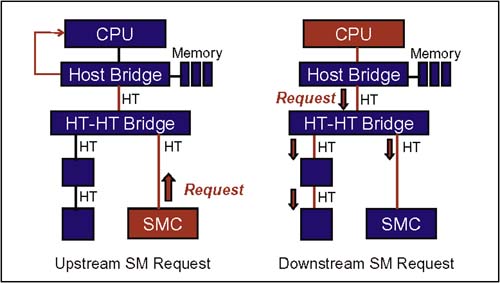Background
| Several x86 processor-specific features require support for both hardware and software compatibility, including:
Other legacy issues related to Industry Standard Architecture (ISA) platforms deal with I/O bus compatibility, rather than processor- related issues. These topics are discussed in the chapter entitled, "I/O Compatibility." Legacy SignalsSupport for the features mentioned above involves a number of X86 signals. These signals include those preserved throughout the x86 processor evolution to maintain compatibility:
Figure 22-1 on page 492 illustrates the typical implementation of these signals in a non-HT system. Note that these signals are typically routed directly between the CPU and South bridge in a legacy platform with PCI. Figure 22-1. CPU Signals Routed Between South Bridge and CPU Legacy Special CyclesSome x86 CPU events are signaled via special cycles. The CPU uses its system interface (e.g. front-side bus) to signal special cycles to the Host Bridge. The events signaled by an x86 CPU include:
Special cycles have various jobs related to x86 functions such as Interrupts, System Management Mode (SMM), power management, and cache coherency. Note that each of the x86 signals and special cycles are discussed within the section that describes the x86 function to which the signal or special cycle relates . System Management MessagesHyperTransport eliminates the direct signal routing between the x86 CPU and the compatibility bridge (South Bridge, ICH, etc.) used in legacy platforms. Instead, HT defines System Management (SM) requests that serve to convey information that otherwise would be conveyed via signals. These messages act as virtual wires that signal INTR, FERR#, IGNNE#, A20M#, STPCLK#, SMI# and SMIACT#. Note that the default state of virtual wires is deasserted. Figure 22-2 on page 494 illustrates that messages may move in either direction. Figure 22-2. SM Request Sources Delivery of special cycle messages is also done via SM messages. When the Host Bridge receives a special cycle from the CPU, it sends an SM message that delivers the special cycle message to interested parties residing on the HT bus. Refer to Chapter 22, entitled "X86 CPU Compatibility," on page 491 for a detailed explanation of the SM messages. |
EAN: 2147483647
Pages: 182

